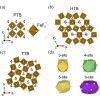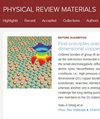First-principles study of strain behavior in iron-based fluorides of tungsten bronze type as cathode materials for alkali-ion batteries
IF 3.4
3区 材料科学
Q2 MATERIALS SCIENCE, MULTIDISCIPLINARY
引用次数: 0
Abstract
Mechanical stresses and strains in the microstructure of cathode materials evolving during charge/discharge cycles can reduce the long-term stability of intercalation type alkali-metal-ion batteries. In this context, crystalline compounds exhibiting zero-strain (ZS) behavior are of particular interest. Near-ZS sodiation was experimentally measured in the tetragonal tungsten bronze (TTB) type compound . Using a first-principles method based on density functional theory, we investigate the potential of iron-based fluoride compounds with tungsten bronze (TB) structures as ZS cathode materials. Simulations were conducted to study the intercalation of the alkali metal ions , and into the TTB and two related TB structures of the cubic perovskite and hexagonal types. We describe compensating local volume effects that can explain the experimentally measured low volume change of . We discuss the structural and chemical prerequisites of the host lattice for a ZS insertion mechanism for alkali ions in TB structures and present a qualitative descriptor to predict the local volume change, which provides a way for faster screening and discovery of novel ZS battery materials.

作为碱性离子电池阴极材料的钨青铜型铁基氟化物应变行为的第一性原理研究
在充放电循环过程中,阴极材料微观结构中的机械应力和应变会降低插层型碱金属离子电池的长期稳定性。在这种情况下,表现出零应变(ZS)行为的结晶化合物尤其引人关注。实验测量了四方钨青铜(TTB)型化合物 NaxFeF3 中接近零应变的钠化现象。我们采用基于密度泛函理论的第一原理方法,研究了具有钨青铜(TB)结构的铁基氟化物化合物作为 ZS 阴极材料的潜力。模拟研究了碱金属离子 Li+、Na+ 和 K+ 在 TTB 和两种相关的立方包晶型和六方型 TB 结构中的插层。我们描述了局部体积补偿效应,它可以解释实验测量到的 NaxFeF3 的低体积变化。我们讨论了 TB 结构中碱离子 ZS 插入机制的宿主晶格结构和化学先决条件,并提出了预测局部体积变化的定性描述方法,这为更快地筛选和发现新型 ZS 电池材料提供了途径。
本文章由计算机程序翻译,如有差异,请以英文原文为准。
求助全文
约1分钟内获得全文
求助全文
来源期刊

Physical Review Materials
Physics and Astronomy-Physics and Astronomy (miscellaneous)
CiteScore
5.80
自引率
5.90%
发文量
611
期刊介绍:
Physical Review Materials is a new broad-scope international journal for the multidisciplinary community engaged in research on materials. It is intended to fill a gap in the family of existing Physical Review journals that publish materials research. This field has grown rapidly in recent years and is increasingly being carried out in a way that transcends conventional subject boundaries. The journal was created to provide a common publication and reference source to the expanding community of physicists, materials scientists, chemists, engineers, and researchers in related disciplines that carry out high-quality original research in materials. It will share the same commitment to the high quality expected of all APS publications.
 求助内容:
求助内容: 应助结果提醒方式:
应助结果提醒方式:


